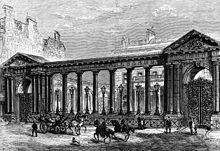Grosvenor House

Grosvenor House was one of the largest private townhouses on Park Lane in London . The Grosvenor family , the Dukes of Westminster , lived in the house for over a century. Their original home was in Millbank , but after the family had built on their property in Mayfair , they built a house on Park Lane to match their wealth, their social status, their 19th century influence. The house was requisitioned during World War I and later sold and demolished. Today the Grosvenor House Hotel stands there .
history


On the site was a small house called Gloucester House (after Prince William Henry, Duke of Gloucester and Edinburgh , to whom it belonged) with a main entrance from Upper Grosvenor Street . This house was bought by Robert Grosvenor, 1st Marquess of Westminster , († 1845) in 1805 for £ 20,000. He had it expanded and modernized for £ 17,000. In 1821 a large picture gallery, 15 meters long, was added to the west of the house. Much of the Grosvenor's treasure was housed there.
Another extension was added in 1842 in the form of a 34-meter-long classic colonnaded entrance facade on Upper Grosvenor Street . At each end there was a triumphal arch with ornate pediments adorned with the Grosvenor coat of arms. Thomas Cundy , the architect of this huge house, then proposed a larger country house that would have filled the entire "Park Street" and was 70 meters long. But the 2nd Marquess did not allow this proposal to be implemented because he considered it too wasteful.
In 1870, Hugh Grosvenor, 3rd Marquess of Westminster , (later 1st Duke) commissioned Henry Clutton to add a vestibule to the north of the house and remodel many of the parade rooms. In 1889 the house was one of the first buildings in London to be electrified.
demolition
The house was owned by the Grosvenors until World War I, when the government requisitioned it. After the war, the family decided it was too wasteful to maintain and sold it. The house was demolished and the Grosvenor House Hotel was built in its place. This hotel was the first Marriott International hotel in the UK. The Grosvenor House Hotel, which hosts some of London's greatest awards ceremonies, was sold to the Indian Sahara conglomerate in December 2010 for £ 470 million . The new owner, Sahara India Pariwar , announced that he would like to run the hotel together with Marriott International.
Art collections
It is said that the house once contained one of the most beautiful art collections in the world. B. Paintings by Thomas Gainsborough , Diego Velázquez, and other old masters. Some of these works of art were sold between the wars, but most are still in the Grosvenor family's other homes today, notably at their Eaton Hall country estate in Cheshire .
Individual evidence
- ^ Johnathan Russell: Sahara buys Grosvenor House Hotel from RBS for £ 470m . The Telegraph. December 31, 2010. Accessed April 11, 2018.
swell
- Edward Walford: Old & New London: A Narrative of Its History, Its People & Its Places . 6 volumes. London 1881. Volume 4. pp. 370-372.
- John Young: A Catalog of the Pictures at Grosvenor House, London; with etchings from the whole collection ... accompanied by historical notices of the principal works . London 1820.
Web links
Coordinates: 51 ° 30 ′ 35.2 " N , 0 ° 9 ′ 19.7" W.